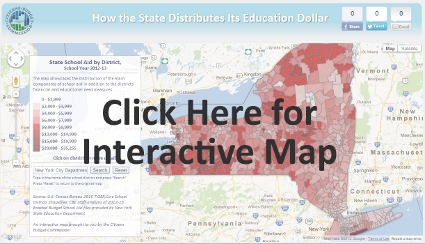How New York State Doles Out its Education Dollar
In school year 2012-13, school districts in New York are expecting to receive $20.4 billion in aid from New York State, an amount that comprises just over 40 percent of their total budgets on average. However, aid per student varies among districts. Some of the variation stems from the needs of the students within district boundaries and from resident taxpayers’ capacity to raise revenue locally. Still, historical patterns established decades ago, kept in place by “hold harmless” provisions built into aid formulas, also drive the distribution.
The CBC's new interactive map documents school aid variation by district. Click on or search for a school district to see state aid per student by major category, as well as measures of district need and ability to pay.
Important takeaways from the map:
- There are more than 40 districts in New York State with enrollment below 300, and 200 with enrollment below 900. Studies have shown that consolidating these districts would result in 7 to 20 percent savings through economies of scale.[1] In particular, districts that are located in close proximity, as they are in the lower Hudson Valley and Long Island, are good candidates for consolidation.
- Districts with similar, or in some cases exactly the same, need-resource index values often receive different aid amounts. For example, the districts of Marlboro and Greenwood, both in the Mid- Hudson region, have need-resource index values of 0.5, but one receives $5,589 and the other $10,672 per student. Part of the variation can be categorical aids that are driven largely by local spending; larger spenders get larger reimbursements. Part may be due to legacy commitments that remain unexamined despite changes in student enrollment or local wealth; so-called "hold harmless" provisions prevent aid from dropping below prior-year levels that are set in statute. For example, in Albion enrollment has dropped by 554 pupils, or 22 percent, since 2006, but the base, or foundation aid, amount has not been reduced. The failure to adjust to changing district circumstances leads to inefficiencies. For example, a district with falling enrollment should close schools to reduce expenses, but may not do so because poorly calibrated State aid does not reflect its actual enrollment counts.
By Elizabeth Lynam and Gal Fix
[1] New York State Commission on Local Government & Competitiveness, 21st Century Local Government: Savings Estimates, April, 2008, http://www.nyslocalgov.org/pdf/Savings_Estimates.pdf.
